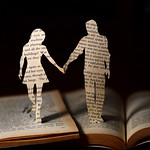[T]he word essay itself comes from the French for try, and "A Try" captures the modest and partial nature of the form. Anything in the world is potential subject matter, and anything you say about it is an attempt to be accurate, to be interesting, to offer a perspective.
Any or all forms of the essay may be enlivened and made more meaningful through attention to imagery, voice, character, setting, and scene—the elements of imaginative writing. Such essays may be called literary nonfiction or creative nonfiction, terms to describe the kinds of essays that include the personal but don't necessarily stay there, that include the factual but search for greater range and resonance. (237)
 |
| Image: Story by rossyyume Copyright 2012, no changes made Creative Commons License |
Imagery, voice, character, setting, scene—these are the elements which set apart creative nonfiction from other forms of nonfiction prose. Visit Creative Nonfiction for more on the genre, noting in particular the many short essays published online, such as the following:
"I survived the Blizzard of '79" by Beth Ann Fennelly
"The Marrying Kind" by Jane Bernstein
"It Wasn't Until I Was an Old Woman..." by Toi Derricotte
"The Wonder of the Look on Her Face" by Brian Doyle

No comments:
Post a Comment